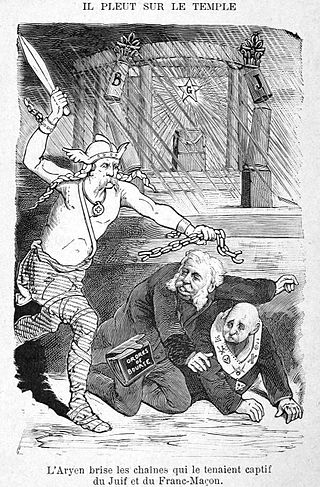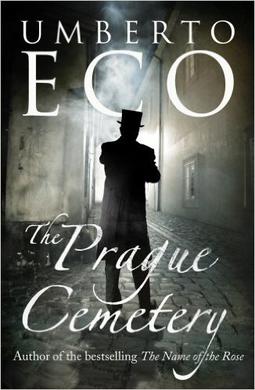Related Research Articles

Augustin Barruel was a French journalist, intellectual, and Jesuit priest. He is now mostly known for setting forth the conspiracy theory involving the Bavarian Illuminati and the Jacobins in his book Memoirs Illustrating the History of Jacobinism published in 1797. In short, Barruel wrote that the French Revolution was planned and executed by the secret societies.

The Zionist occupation government, Zionist occupational government or Zionist-occupied government (ZOG), sometimes also referred to as the Jewish occupational government (JOG), is an antisemitic conspiracy theory claiming Jews secretly control the governments of Western states. It is a contemporary variation on the centuries-old belief in an international Jewish conspiracy. According to believers, a secret Zionist organization is actively controlling international banks, and through them governments, in order to collude against white, Christian, or Islamic interests.
Hundreds of conspiracy theories about Freemasonry have been described since the late 18th century. Usually, these theories fall into three distinct categories: political, religious, and cultural. Many conspiracy theories have connected the Freemasons with worship of the devil; these ideas are based on different interpretations of the doctrines of those organizations.

Maurice Joly was a French political writer and lawyer known for The Dialogue in Hell Between Machiavelli and Montesquieu, a political satire of Napoleon III.

Nesta Helen Webster was an English author who revived conspiracy theories about the Illuminati. She claimed that the secret society's members were occultists, plotting communist world domination, through a Jewish cabal, the Masons and Jesuits. She blamed the group for events including the French Revolution, 1848 Revolution, the First World War, and the Bolshevik Revolution. Her writing influenced later conspiracy theories and ideologies, including American anti-communism and the militia movement.

The Dialogue in Hell Between Machiavelli and Montesquieu is a political satire written by French attorney Maurice Joly in protest against the regime of Napoleon III, who ruled France from 1848 to 1870. It was translated into English in 2002. Small portions were translated in 1967 as an appendix to Norman Cohn's Warrant for Genocide, which identifies it as the main source of the later Protocols of the Elders of Zion, though The Dialogue itself makes no mention of Jews.

Hermann Ottomar Friedrich Goedsche, also known by his pseudonym Sir John Retcliffe, was a German government employee and author who is remembered mainly for his antisemitism.
Antisemitism in Japan has developed over the years despite the presence of a relatively small and obscure Jewish population. Japan had no traditional antisemitism until nationalist ideology and propaganda began to spread on the eve of World War II. Before and during the war, Nazi Germany, an ally to the Japanese, encouraged Japan to adopt antisemitic policies. In the post-war period, extremist groups and ideologues have promoted conspiracy theories.
William James Guy Carr was an English-born Canadian naval officer, author.
Leslie Fry was the pen name of Paquita Louise de Shishmareff. She was an American antisemitic, pro-fascist author, who is primarily known for Waters Flowing Eastward (1931), a book which asserts that Jews were to blame for both Capitalism and Bolshevism, and that it was primarily certain Jews who started World War I. She alleged that certain Freemasons were involved as well. She postulated that the ultimate aim of these particular Jews and Freemasons was "World Domination". These conclusions were based in part on her study of the Protocols of the Elders of Zion.
The Franklin Prophecy, sometimes called the Franklin Forgery, is an antisemitic speech falsely attributed to Benjamin Franklin, warning of the supposed dangers of admitting Jews to the nascent United States. The speech was purportedly transcribed by Charles Cotesworth Pinckney during the Constitutional Convention of 1787, but was unknown before its appearance in 1934 in the pages of William Dudley Pelley's Silver Legion pro-Nazi magazine Liberation. No evidence exists for the document's authenticity, and some of Pelley's claims have actively been disproven.
Antisemitic tropes or antisemitic canards are "sensational reports, misrepresentations, or fabrications" that are defamatory towards Judaism as a religion or defamatory towards Jews as an ethnic or religious group. Since as early as the 2nd century, libels or allegations of Jewish guilt and cruelty emerged as a recurring motif along with antisemitic conspiracy theories.

The Judeo-Masonic conspiracy is an antisemitic and anti-Masonic conspiracy theory involving an alleged secret coalition of Jews and Freemasons. These theories are popular on the far-right, particularly in France, Turkey, Spain, Portugal, Italy, Germany, Russia, Serbia, Eastern Europe, and Japan, with similar allegations still being published.

The Protocols of the Elders of Zion, or The Protocols of the Meetings of the Learned Elders of Zion, is a fabricated text purporting to detail a Jewish plot for global domination. Largely plagiarized from several earlier sources, it was first published in Imperial Russia in 1903, translated into multiple languages, and disseminated internationally in the early part of the 20th century. It played a key part in popularizing belief in an international Jewish conspiracy.
The Protocols of the Elders of Zion is a fabricated antisemitic text purporting to describe a Jewish plan to achieve global domination. The text was fabricated in the Russian Empire, and was first published in 1903. While there is continued popularity of The Protocols in nations from South America to Asia, since the defeat of Nazi Germany, Fascist Italy, and Imperial Japan in World War II, governments or political leaders in most parts of the world have generally avoided claims that The Protocols represent factual evidence of a real Jewish conspiracy. The exception to this is the Middle East, where a large number of Arab and Muslim regimes and leaders have endorsed them as authentic. Past endorsements of The Protocols from Presidents Gamal Abdel Nasser and Anwar Sadat of Egypt, Iraqi President Arif, King Faisal of Saudi Arabia, and Colonel Muammar al-Gaddafi of Libya, among other political and intellectual leaders of the Arab world, are echoed by 21st century endorsements from the Grand Mufti of Jerusalem, Sheikh Ekrima Sa'id Sabri, and Hamas, to the education ministry of Saudi Arabia.

The Prague Cemetery is a novel by Italian author Umberto Eco. It was first published in October 2010; the English translation by Richard Dixon appeared a year later. Shortlisted for the Independent Foreign Fiction Prize in 2012, it has been described as Eco's best novel since The Name of the Rose.
Jan Udo Holey, and often known by his pen name Jan van Helsing, is a controversial German author who embraces conspiracy theories involving subjects such as world domination plots by freemasons, Hitler's continuing survival in Antarctica following World War II, the structure of the earth as hollow, and others. His theories draw from sources such as The Protocols of the Elders of Zion.

Iakov Aleksandrovich Brafman, commonly known as Jacob Brafman, was a Lithuanian Jew from near Minsk, who became notable for converting first to Lutheranism and then the Russian Orthodox Church. He advanced conspiracy theories against the Qahal and the Talmud. Brafman's works The Local and Universal Jewish Brotherhoods (1868) and The Book of the Kahal (1869) were foundational texts in establishing a theoretical basis for modern antisemitic thought in Russia and established a framework for themes later covered in The Protocols of the Elders of Zion.
The international Jewish conspiracy or the world Jewish conspiracy has been described as "the most widespread and durable conspiracy theory of the twentieth century" and "one of the most widespread and long-running conspiracy theories". Although it typically claims that a malevolent, usually global Jewish circle, referred to as International Jewry, conspires for world domination, the conspiracy theory's content is extremely variable, which helps explain its wide distribution and long duration. It was popularized in the late nineteenth and early twentieth century especially by the antisemitic forgery The Protocols of the Elders of Zion. Among the beliefs that posit an international Jewish conspiracy are Jewish Bolshevism, Cultural Marxism, Judeo-Masonic conspiracy theory, White genocide conspiracy theory and Holocaust denial. The Nazi leadership's belief in an international Jewish conspiracy that it blamed for starting World War II and controlling the Allied powers was key to their decision to launch the Final Solution.
Frederick van Millingen (1836–1901) was an English army officer and writer. Born in Istanbul, he took the name Osman Bey and joined the Ottoman Army for several years. He later took the name Vladimir Andreevich and converted to Russian Orthodox Christianity. Frederick van Millingen is most notorious for being the author of The Conquest of the World by the Jews, an antisemitic work first published in 1873.
References
- 1 2 Oberhauser, Claus (31 March 2020). "Simonini's letter: the 19th century text that influenced antisemitic conspiracy theories about the Illuminati". The Conversation . Retrieved 2023-04-11.
- ↑ Le Contemporain Paris, July 1878, p. 58.
- ↑ Norman Cohn Warrant for genocide: the myth of the Jewish world-conspiracy and the Protocols of the elders of Zion, London, Eyre & Spottiswoode, 1967, pp. 27-28.
- ↑ Markner, Reinhard (April 1, 2014). "Giovanni Battista Simonini: Shards from the Disputed Life of an Italian Anti-Semite". Kesarevo Kesarju. Scritti in Onore di Cesare G. De Michelis. A Cura di Marina Ciccarini, Nicoletta Marcialis e Giorgio Ziffer. Firenze UP– via www.academia.edu.
- ↑ Cohn pp. 27-28
- ↑ Cohn, p. 27.
- ↑ Cohn pp. 28, 30.
- ↑ Cohn pp. 30-31.